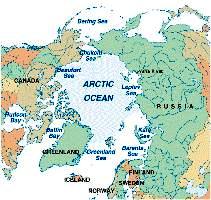Russian expedition and reactions
The Russian flag provoked an immediate three-day Arctic trip of the Canadian Prime Minister, Stephen Harper, followed by strong statements from Norway which has Arctic claims, and an expedition from Denmark, whose Greenland possessions allow it to claim that the disputed Lomonosov Ridge, a 1,240-mile underwater mountain range, is attached to Greenland. The Danish Minister of Science and Technology, Helge Sander, said “No matter how many flags you plant or how many prime ministers you send, that doesn’t become a valid parameter in the process”. However, to make sure that the Danish flag is seen, Denmark has plans for two more expeditions to justify its claims. Not to be left behind, the US Coast Guard is sending a ship this year, the cutter Healy, to map the sea floor on the northern Chuhchi Cap, an underwater plateau that extends from Alaska some 1,500 miles northward.
The Russian expedition was led by Arthur Chilingarov, an Arctic explorer who is also a vice-president of the Russian Parliament, the Douma, so that the dropping of the flag is a symbol that will be brought quickly to the attention of Russian lawmakers. The expeditions reflect the growing rivalry between Russia, the USA, Canada, Norway and Denmark for the Arctic’s underwater riches, an estimated 10 billion dollars of riches, in particular, oil and gas. Iceland has also presented claims but is a less active participant in the scramble.
UN Structures
Fortunately, there are UN structures which should prevent a free-for-all battle based only on political influence. The Third Law of the Sea Conference created a UN body – the Commission on the Limits of the Continental Shelf – whose mandate is to decide the claims concerning the continental shelf. The Commission is made up of independent experts drawn from states which have ratified the 1982 Law of the Sea Convention. Thus, there are no US members on the Commission as the USA has not ratified the Convention, due to narrow nationalistic fears in the US Senate. There are efforts currently underway to revive Senate action on the Law of the Sea Convention, but even if the USA ratifies, there will not be a vacant seat on the Continental Shelf Commission for some time. As with all UN bodies made up of independent experts, some members are more independent than others, and some are more expert than others. The Continental Shelf Commission is to base its decisions on geological evidence, but politics is never far away.
The rather complicated Continental Shelf issues arise from the results of the Third UN Law of the Sea Conference which began in Caracas in 1974 and whose Convention came into force in 1982. There had been two earlier UN Conferences on the Law of the Sea in 1958 and 1960 but with rather narrow legal agendas. By the time of the Third Conference, many colonial countries had become independent and wanted a role in what was presented at the time as the most important legal gathering since the 1945 San Francisco Conference launched the UN. Moreover, many “geographically disadvantaged” nations such as those who were landlocked or with short coasts were determined not to be left out. Geography often won over Cold War ideology as Swiss and Nepalese diplomats led the landlocked caucus.

The momentum for the Third Law of the Sea Conference had begun with a historic speech in the UN General Assembly in 1967 by Ambassador Arvid Pardo of Malta who developed the idea of the common heritage of mankind for the sea-bed and the ocean floor beyond the limits of national jurisdiction. Pardo also had a strong ecological concern stressing that “nations must do together what they cannot do singly. Since none of them can conserve the ocean environment and prevent pollution individually, they must do it together”.
US international law scholars, in particular Louis Sohn, professor of international law at Harvard, had played an important role in setting the intellectual foundations for the conference. The US Draft Ocean Treaty presented in 1970 was very international and generous in a common heritage of mankind direction. Later, the Treasury Department and the Office of Management and Budget gutted the US Draft, leaving however the innovative sections on the settlement of disputes to which Sohn had largely contributed.
The Law of the Sea Conference which ran from 1974 to 1980 – “the longest running show on Broadway” as some called it – was held at a time when many diplomats felt that there would be a world-wide struggle for resources. There was the 1973 Arab oil boycott and the resultant steep rise in petroleum prices. Howard Hughes had just launched a new ocean mining vessel, the Hughes Glomar Explorer, which many saw as a sign that only the most technologically advanced – either private or State-owned companies – would have access to hard minerals on the sea floor, in particular manganese nodules which contain copper, nickel and cobalt as well as manganese.
The fear of a resource battle led governments to place as much of the seabed as possible under national control – leading to what some called “the law of the seize”. Under the Convention, every State has the right to exploit the ocean floor and the seabed up to 200 nautical miles off its coast, provided that the area does not overlap with the seabed of other States. In addition, States can establish the right to further seabed if they can prove with geological evidence that their continental shelves extend more than 200 miles beyond their coasts. Underwater mountains as in the Arctic can be considered as part of their continental shelf if they are linked or were linked to the above-sea continental shelf.
A State must present its evidence to the UN Commission on the Continental Shelf, but only after ratifying the Convention on the Law of the Sea. All States involved in the Arctic Ocean continental shelf have ratified the Convention except the USA. Thus, the Commission on the Limits of the Continental Shelf takes on added importance.
The only alternative to the application of the Law of the Sea Convention would be a new treaty among only those States concerned with the Arctic Ocean sea bed. The precedent for such a treaty is the Treaty on the Antarctic in which 12 countries ratified a treaty to create a legal framework to govern the southernmost continent. Some, such as Scott Borgerson, who teaches maritime studies at the US Coast Guard Academy and is a fellow at the Council on Foreign Relations, are looking to the Antarctic Treaty of 1959 as a model to prevent an Arctic race for oil by avoiding the provisions of the Law of the Sea Convention which the USA has not signed.
The current Antartic Treaty
Since the Antarctic Treaty is bedside reading for only a few, it is useful to look at its provisions and to see if it can be a useful precedent . The Antarctic Treaty was drafted largely as a way to avoid a clash of sovereignty among seven states, some of whose claims to territory in Antarctica overlap, in particular Chile, Argentina and the United Kingdom. The claims were highlighted in 1958 which the United Nations proclaimed as International Geophysical Year, and there were at least twelve national expeditions that year in the Antarctic.
It is believed that the Antarctic continent once existed in close juxtaposition with Australia, South Africa, South America, and India in an original super-continent, Gondwanaland. Since the latter areas are all well endowed with minerals, it is assumed that the Antarctic must be likewise. While extraction would be difficult and expensive, the price of oil and minerals could make extraction financially worthwhile.
The success of the 1958 International Geophysical Year encouraged hopes of making the spirit of scientific co-operation more permanent, leading to the 1959 Antarctic Treaty among twelve states – those with sovereignty claims and five additional states which had participated in the expeditions of the Geophysical Year.
The Treaty has four notable components. First, it established the world’s first nuclear-free zone, preventing the placing of nuclear weapons and nuclear waste. The Treaty did not rule out the civilian use of nuclear energy, and so the USA installed a nuclear power plant at its McMurdo Base. It failed to live up to its expectations and was decommissioned in 1978. Since it was decommissioned, it then became radioactive waste, and the material had to be shipped back to the USA at almost the same cost as originally building it.
Second, the Antarctic Treaty has frozen land claims, such as those of the UK, Chile and Argentina which overlap. The USA and the Soviet Union by contrast did not make any claims but did not recognise the claims of others. The Treaty froze the issue. No new claims were to be made but the current claimants were not forced to give up what they already claimed. Meanwhile, for those states that did not recognise any of the claims, the Treaty permitted them to continue their policy of non-recognition. Third, the Treaty guaranteed international co-operation in scientific investigation. There is an exchange of information regarding scientific programs, as well as co-operation among scientific personnel.
Finally, there is a strong international mechanism to supervise the implementation of the Treaty. This international mechanism also contains an obligation among the nations concerned to settle their disputes peacefully by negotiation and inquiry, mediation, conciliation, arbitration, judicial settlement or other peaceful means of their own choice.
The Antarctic Treaty of 1959 is a product of a bygone era
The Treaty has worked well. While political disputes come and go, the challenges of science remain. In the mid-1970s during the negotiation on the Law of the Sea Convention, Sri Lanka proposed that the Convention should apply to the Antarctic. This idea was beaten back by the 12 states party to the Antarctic Treaty; the UK, USA and USSR having a good number of allies or clients. Thus it was agreed that the Antarctic should not be dealt with by the Law of the Sea negotiations nor by its Convention. A few states, in particular Malaysia had raised the issue in the mid 1980s in the UN General Assembly, but were never able to build up momentum to really question the Treaty – a deal among a small number of powerful states. The Antarctic Treaty of 1959 is a product of a bygone era. It was created at a time when many states were still colonies of European powers and so were largely ignored in international politics. Thus a handful of developed states could determine the outcome of a large area without recourse to advice from Asia or Africa. Today, such a treaty among only a few states is less possible even if the outcome of the Antarctic Treaty has been largely positive.
Concerning the North Pole, the Arctic states – Canada, Denmark, Finland, Iceland, Norway, Sweden, Russia, and the USA – participate in an intergovernmental body, the Arctic Council concerned largely with environmental questions. Could the Arctic Council serve as a focus for drafting a wider treaty among these states to deal with sovereignty claims, shipping lanes, the development of oil and mineral resources, and the welfare of nearly one million indigenous peoples living within the Arctic Circle? This is one of the questions facing the international community. The quality of the answers given will have to concern more than international lawyers.


Follow the comments: |
|
